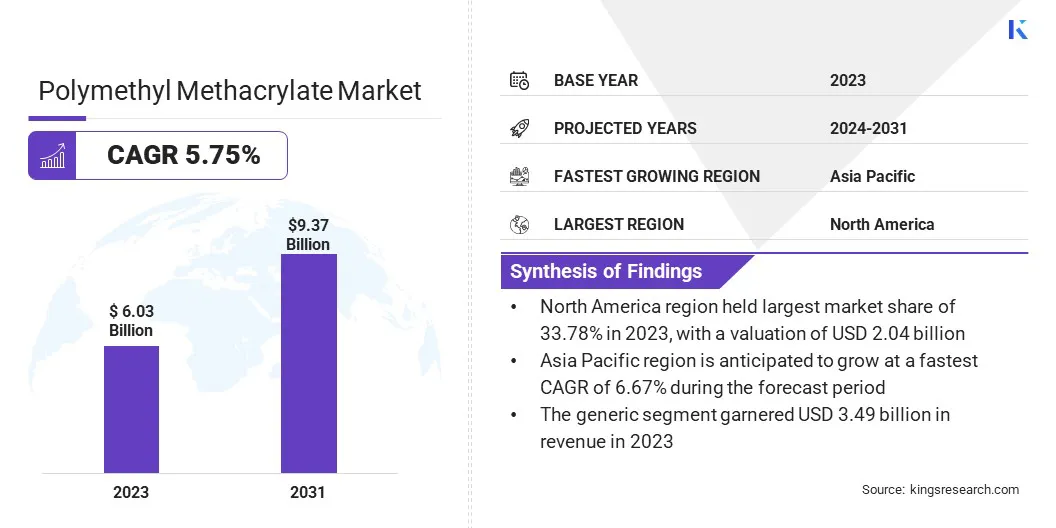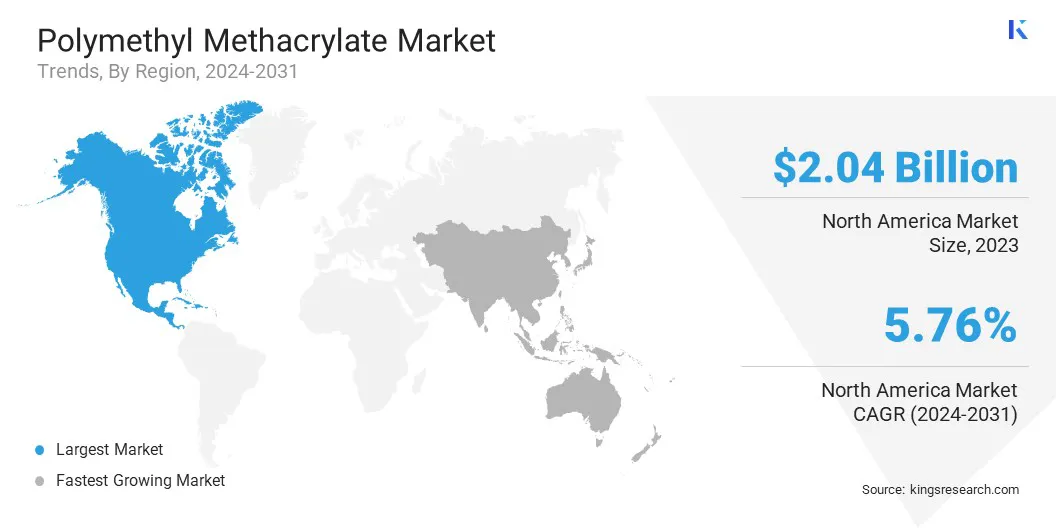Market Definition
The polymethyl methacrylate (PMMA) market encompasses the production, distribution, and application of PMMA, a transparent, lightweight, and shatter-resistant thermoplastic. PMMA is widely used as a glass substitute in industries such as automotive, construction, electronics, and healthcare due to its excellent optical clarity, weather resistance, and durability.
Polymethyl Methacrylate Market Overview
The global polymethyl methacrylate market size was valued at USD 6.03 billion in 2023 and is projected to grow from USD 6.33 billion in 2024 to USD 9.37 billion by 2031, exhibiting a CAGR of 5.75% during the forecast period.
This growth is driven by increasing demand across industries such as automotive, construction, electronics, and healthcare, where PMMA’s superior optical clarity, durability, and lightweight properties make it the preferred material.
Major companies operating in the global polymethyl methacrylate industry are Trinseo, Röhm GmbH, LOTTE Chemical CORPORATION, KURARAY CO., LTD., Mitsubishi Chemical Group., Plaskolite, LG Chem, CHIMEI, Spartech LLC, SABIC, Sumitomo Chemical Asia Pte Ltd, MADREPERLA S.p.a., Wanhua, Unigel, Asahi Kasei Corporation, and others.
Technological advancements, rising adoption of LED displays and medical applications, and the expansion of bio-based PMMA are contributing to market expansion, supported by growing investments in product innovation and sustainability.
- In July 2024, ALFAPLAS launched LED-ready cast acrylic sheets, integrating premium cast acrylic with advanced LED compatibility. Designed for designers, architects, and DIY professionals, these sheets offer enhanced illumination, durability, and design flexibility, rendering them ideal for innovative lighting and architectural applications.

Key Highlights:
- The global polymethyl methacrylate market size was recorded at USD 6.03 billion in 2023.
- The market is projected to grow at a CAGR of 5.75% from 2024 to 2031.
- North America held a share of 33.78% in 2023, valued at USD 2.04 billion.
- The extruded sheet segment garnered USD 1.62 billion in revenue in 2023.
- The generic segment is expected to reach USD 5.42 billion by 2031.
- The automotive segment is projected to generate a revenue of USD 2.56 billion by 2031.
- Asia Pacific is anticipated to grow at a CAGR of 6.67% over the forecast period.
Market Driver
"Rising Demand from Automotive and Electronics Industries"
The polymethyl methacrylate (PMMA) market is experiencing significant growth due to rising demand from the automotive and electronics industries. In the automotive sector, manufacturers are increasingly utilizing PMMA as a lightweight alternative to glass for headlights, windows, and interior components to enhance fuel efficiency and vehicle performance.
With high optical clarity, impact resistance, and weather durability, PMMA is widely used in modern LED lighting systems and automotive displays. In the electronics industry, the expanding adoption of LED screens, display panels, and optical fibers is boosting the demand for PMMA due to its exceptional transparency and scratch resistance.
The growing penetration of smartphones, tablets, and smart TVs, particularly in emerging markets, is further propelling market expansion.
- In March 2024, SABIC launched LNP ELCRIN SLX resin, reinforcing the trend toward paint-free, high-durability materials in automotive and electronics. This specialty material offers enhanced scratch resistance, a high-gloss surface finish, and a molded-in color solution for exterior components, eliminating the need for traditional painting. This innovation supports the growth of the market, fueled by surging demand for weather-resistant, lightweight alternatives that enhance aesthetics, performance, and sustainability.
Market Challenge
"Environmental Concerns and Recycling Limitations"
A major challenge hampering the expansion of the polymethyl methacrylate (PMMA) market is its environmental impact. Traditional PMMA is derived from petrochemical-based raw materials, contributing to carbon emissions during manufacturing. Additionally, PMMA is non-biodegradable, presenting challenges in waste management and sustainability compliance.
To address this challenge, companies are investing in recyclable and bio-based PMMA solutions. Advanced mechanical and chemical recycling techniques are being developed to enhance PMMA recovery and reuse, reducing reliance on virgin raw materials.
Bio-based PMMA, derived from renewable sources, is emerging as a sustainable alternative, offering similar performance characteristics while lowering environmental impact.
Market Trend
"Increasing Adoption of PMMA in Healthcare Applications"
A major trend influencing the polymethyl methacrylate (PMMA) market is its growing adoption in healthcare and medical applications. PMMA is widely used in the medical device and orthopedic due to its biocompatibility, transparency, and sterilization capability.
It serves as a crucial material in dental prosthetics, intraocular lenses, orthopedic implants, and bone cement. The increasing prevalence of age-related vision disorders is creating a strong demand for PMMA-based intraocular lenses, particularly in aging populations across North America, Europe, and Asia.
- In June 2024, Biesterfeld, a leading global distributor of specialty chemicals, pharma, and food ingredients, partnered with Spectrum Plastics Group, a DuPont business specializing in polymer-based medical device components. Under this agreement, Biesterfeld will represent and promote Spectrum’s medical device technologies across the DACH region, strengthening its presence in the healthcare sector.
Polymethyl Methacrylate Market Report Snapshot
|
Segmentation
|
Details
|
|
By Form
|
Extruded Sheet, Acrylic Sheet, Beads, Pellets, Others
|
|
By Grade
|
Generic, Optical
|
|
By End Use
|
Automotive, Electrical & Electronics, Construction, Industrial & Machinery, Healthcare, Others
|
|
By Region
|
North America: U.S., Canada, Mexico
|
|
Europe: France, U.K., Spain, Germany, Italy, Russia, Rest of Europe
|
|
Asia-Pacific: China, Japan, India, Australia, ASEAN, South Korea, Rest of Asia-Pacific
|
|
Middle East & Africa: Turkey, UAE, Saudi Arabia, South Africa, Rest of Middle East & Africa
|
|
South America: Brazil, Argentina, Rest of South America
|
Market Segmentation
- By Form (Extruded Sheet, Acrylic Sheet, Beads, Pellets, and Others): The extruded sheet segment earned USD 1.62 billion in 2023 due to its cost-effectiveness, superior surface finish, and ease of processing, making it a preferred choice across automotive, construction, and signage industries.
- By Grade (Generic and Optical): The generic segment held a notable share of 57.87% in 2023, fueled by its versatility, affordability, and widespread application across multiple industries.
- By End Use (Automotive, Electrical & Electronics, Construction, and Industrial & Machinery, Healthcare, and Others): The automotive segment is projected to reach USD 2.56 billion by 2031, propelled by the increasing adoption of PMMA in vehicle lighting, glazing, and interior applications.
Polymethyl Methacrylate Market Regional Analysis
Based on region, the global market has been classified into North America, Europe, Asia Pacific, Middle East & Africa, and Latin America.

North America polymethyl methacrylate market captured a share of around 33.78% in 2023, valued at USD 2.04 billion. This dominance is reinforced by strong demand from the automotive, electronics, and construction sectors.
The regional market benefits from the presence of key manufacturers, advanced R&D capabilities, and increasing adoption of lightweight materials in industries prioritizing fuel efficiency and sustainability. Rising investments in renewable energy, healthcare infrastructure, and high-performance plastics further contribute to regional market expansion.
The United States dominates the regional market, supported by technological advancements, growing EV production, and the extensive use of PMMA in LED displays and medical devices.
The polymethyl methacrylate industry in Asia Pacific is poised to grow at a CAGR of 6.67% over the forecast period, charaterized by rapid industrialization, expanding automotive production, and increasing infrastructure development across key economies such as China, India, Japan, and South Korea.
The Asia Pacific polymethyl methacrylate market benefits from strong demand from the construction, electronics, and healthcare sectors, where PMMA is widely used for windows, display panels, and medical devices. Rapid urbanization, growing disposable income, and favorable government initiatives supporting electric vehicles (EVs) are fueling the adoption of PMMA.
- In March 2024, the Minister of Civil Aviation and Steel announced plans to launch 15 airport projects worth USD 12.1 billion, slated for completion by 2028. This expansion is expected to boost demand for polymethyl methacrylate (PMMA) in applications such as windows, signage, lighting systems, and interiors, boosting growth in the construction and transportation sectors.
Regulatory Frameworks
- In the U.S., the Food and Drug Administration (FDA) regulates the polymethyl methacrylate (PMMA) market for medical devices, dental applications, and food-contact materials, ensuring compliance with safety, quality, and performance standards.
- In Europe, the European Commission (EC) oversses the PMMA marketthrough policies on sustainability, waste management, and industrial standards, ensuring adherence to environmental and safety regulations under initiatives such as the Circular Economy Action Plan.
- In India, the Bureau of Indian Standards (BIS) regulates the market by setting quality and safety standards for its use in construction, automotive, and industrial sectors. This ensures compliance with industry benchmarks and enhances product reliability in domestic and international markets.
Competitive Landscape
The global polymethyl methacrylate market is characterized by a large number of participants, including both established corporations and emerging players. Leading companies focus on strategic expansions, mergers & acquisitions, product innovations, and sustainability initiatives to strengthen their market position.
Key players invest in research and development (R&D) to enhance PMMA properties, such as impact resistance, UV stability, and recyclability, catering to evolving industry demands.
Additionally, increasing competition from regional manufacturers in Asia Pacific is reshaping market dynamics. Companies are further prioritizing bio-based PMMA solutions to align with sustainability goals, regulatory requirements, and growing consumer preferences for eco-friendly materials.
- In October 2023, Mitsubishi Chemical Group (MCG) and Honda Motor Co., Ltd. co-developed an advanced PMMA (acrylic resin) material for automotive body parts. Showcased in Honda’s SUSTAINA-C and Pocket Concept models at JAPAN MOBILITY SHOW 2023, this high-impact, color-tunable resin enhances durability, aesthetics, and sustainability by eliminating the need for painting and reducing CO₂ emissions.
List of Key Companies in Polymethyl Methacrylate Market:
- Trinseo
- Röhm GmbH
- LOTTE Chemical CORPORATION
- KURARAY CO., LTD.
- Mitsubishi Chemical Group.
- Plaskolite
- LG Chem
- CHIMEI
- Spartech LLC
- SABIC
- Sumitomo Chemical Asia Pte Ltd
- MADREPERLA S.p.a.
- Wanhua
- Unigel
- Asahi Kasei Corporation
Recent Developments (Partnership)
- In February 2025, Trinseo and Lapo Srl partnered to develop eyewear lenses containing at least 86% recycled polymethyl methacrylate (PMMA) resins, reflecting the market's shift toward sustainability and innovation through recycled materials.


